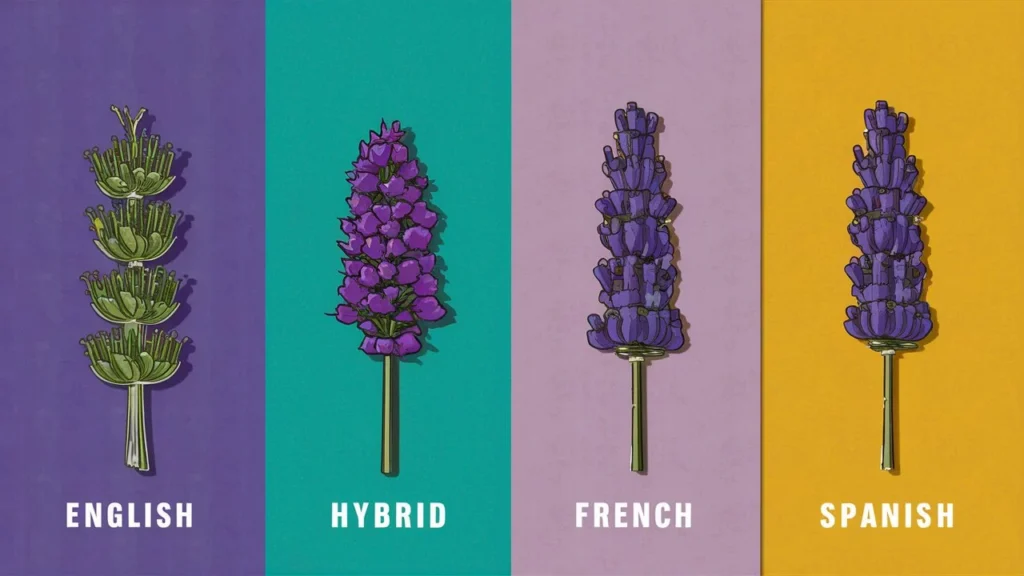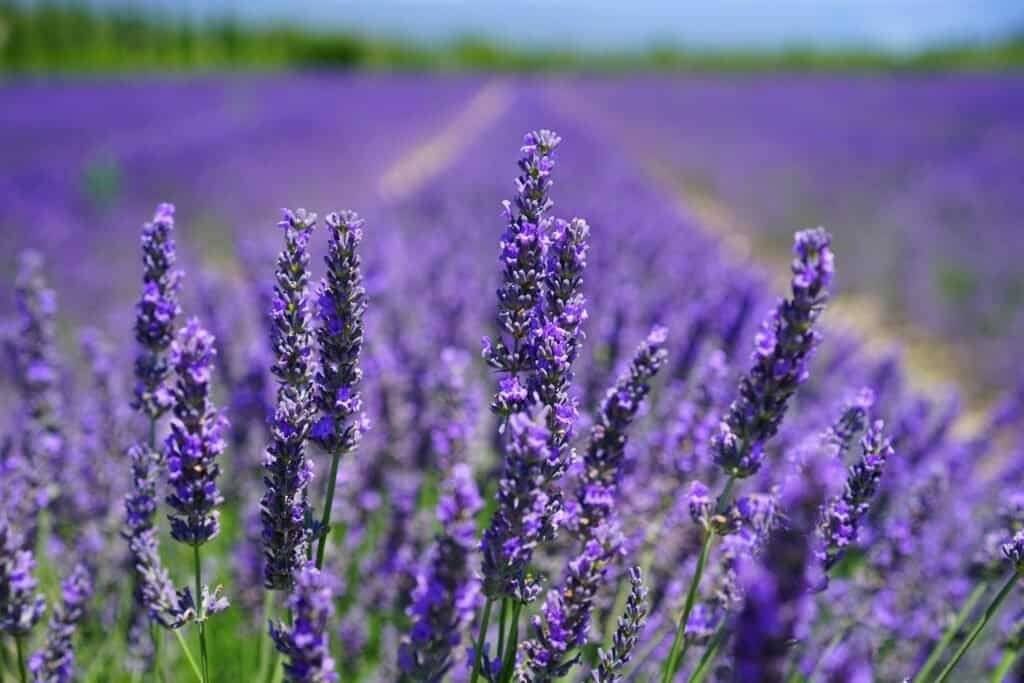Best Lavender Varieties: Top 7 Types to Enhance Your Garden
Today, we’re diving into the world of lavender. I’ll be sharing insights on the top seven most popular varieties, particularly those you’re likely to find at your local garden center. Additionally, we’ll cover some basic information about lavender, the different types available, and which might be best suited for your garden. This guide is especially geared toward beginners or those who haven’t tried growing lavender yet.
We’ve all admired stunning hedges or fields of lavender in pictures, and who wouldn’t want that in their yard? Whether you love the scent or the aesthetic appeal of lavender, this guide aims to help you choose the right variety for your space, ensuring you don’t invest in a plant that won’t thrive in your garden.
Table of Contents
Things You Should Know About Lavender
Lavender: A Low-Maintenance Marvel
Lavender is an exceptional plant, known for its low maintenance and high productivity. In my garden, they return beautifully every year. Some varieties bloom up to three times a season, maintaining their beauty even without deadheading.
Ideal Growing Conditions
Lavender thrives in full sun, preferring six to eight hours of sunlight daily. They favor hot, dry conditions and require well-draining soil. While first-year plants need extra watering, established lavender plants are low-water users, ideal for sustainable gardening.
Lavender is tolerant of poor soil, provided it’s well-draining. Heavy, boggy clay soils are unsuitable, but rocky, sandy soils are perfect. They also thrive in high pH soils and are resistant to deer and rabbits, making them a great choice for many gardens.

Versatility and Fragrance
Lavender can withstand radiant heat from buildings and sidewalks, making it a versatile choice for various planting locations. Their fragrance is a major attraction, perfect for perfuming the air and creating beautiful dried flower arrangements.
Types of Lavender

There are four basic groups of lavender, each offering unique characteristics:
- English Lavender (Lavandula angustifolia)
- Hybrid Lavender (Lavandula x intermedia)
- French Lavender (Lavandula dentata)
- Spanish Lavender (Lavandula stoechas)
English Lavender: The Sweet-Scented Favorite
Sweet Romance
Compact and Colorful: Sweet Romance grows 12 to 18 inches tall and wide, blooming throughout the season with intense, dark-colored blooms. It’s a zone 5 through 9 variety, blooming earlier than most others.
Lavender Munstead
Compact with a Gorgeous Scent: Munstead is 12 to 18 inches tall and wide, known for its rosy lavender blooms. It’s versatile, thriving even in part shade, making it an adaptable choice for various garden conditions.
Lavender Hidcote
Long Stems and Light Lavender Color: Hidcote grows about 3 by 3 feet, producing long stems ideal for cutting. It’s a favorite among local lavender growers for its performance and scent.
Hybrid Lavender: High Oil Content and Potent Scent
Aromatico Blue Improved Lavender
Deep Purple and Narrow Growth: Aromatico Blue Improved has a rich eggplant purple color and stays narrow, making it suitable for borders and containers.
Grosso Lavender
Large and Productive: Grosso Lavender grows up to 3.5 feet tall and wide, known for its silver-tinged leaves and high productivity. It’s perfect for cutting and creating lavender products.
Phenomenal Lavender
Fast-Growing and Humidity Tolerant: Phenomenal Lavender grows 2.5 to 3 feet tall and wide, establishing quickly and thriving in high humidity areas.
Sensational Lavender
Compact and Vibrant: Sensational Lavender is tolerant of high humidity, growing 18 inches tall with bloom spikes up to 30 inches, making it a striking addition to any garden.
I hope this guide helps you navigate the world of lavender and make it easier to choose the right variety for your garden. The seven varieties I’ve shared are well-suited for perennial growth in lower zones, ensuring your garden is filled with the beauty and fragrance of lavender for years to come.







 *(Include an image of droopy leaves)* Some plants, such as calatheas, prefer moist soil at all times; otherwise, they develop that signature brown tissue damage on the leaves. The annoying thing here is that the damage cannot be reversed and can only be cut away, leaving you with a damaged plant. If the soil of your plant is bone dry, you'll notice that it's pulling away from the sides of the pot. This is because the soil has shrunk due to a lack of moisture, so make sure you are not letting this happen by watering a little more frequently. #### Signs Your Plant is Overwatered (darkgreen) Overwatering plants is a really common way that people kill their plants. Beginner plant enthusiasts often have a common misconception that houseplants need lots of water, but the reality is that these plants are native to hot climates where they may get periods of drought followed by large rain which rehydrates them. **Yellowing leaves** (red) can indicate an overwatering problem as well as an underwatering problem. If you are watering your plant too often and the soil is always wet, this can lead to root rot, which will begin to affect the leaves of your plant. **Limp and mushy leaves** (red) also indicate that you are overwatering your plant. This is particularly true with succulents such as Echeverias. Echeverias store water in their thick leaves and have difficulty storing excess water if you are watering your plant too often. This leads to mushy plants that eventually fall off.  *(Include an image of yellowing leaves)* Philodendron and Pothos plants tend to get mushy leaves that fall off if the soil is consistently soggy. My Philodendron Birkin recently developed some new brown leaves that fell off because I was overwatering it. Whereas crispy brown edges on leaves indicate an underwatering problem, if the whole leaves are turning brown, this tends to mean that the plant tissue is rotting due to too much water. You may also notice some water droplets on the ends of the leaves of some of your plants. This is the plant perspiring excess water through its leaves and can indicate that you are giving the plant too much water. Now, this tends to happen on plants that prefer drier soil, and I notice it quite often on my Philodendron Birkin and my Tradescantia Nanook. **Increased presence of fungus gnats** (red) can also be a sign that your plant is too moist. Fungus gnats like a moist top two inches of soil to breed and lay their eggs, so if your soil is wet, it creates a breeding ground for gnats. If you see lots of flea-like flies jumping around the top of your soil, I would just dial back on the watering and let the top two inches of the soil dry out before watering again. #### Watering Tips (darkgreen) It is important to allow the soil of your houseplant to dry out between waterings. This prevents the possibility of over-watering, which is one of the most common reasons people kill their plants. **Check the soil moisture** (red) before watering your plant by sticking your finger two inches into the soil. If it feels wet, leave it a few days and then check again. An even better way to check the soil moisture is to invest in a moisture meter. This device needs no batteries and tells you exactly how much moisture is in the soil, giving you control over watering your plants.  *(Include an image of a moisture meter)* When you identify that your plant needs water, make sure you give it a thorough soaking. Take your plant to a sink area and soak the soil four or five times until water drains out of the bottom each time. This ensures that all the soil in the pot gets moistened and there are no dry patches. **Bottom watering** (teal) is a method that has changed the health of my plants since I implemented it a couple of years ago. Place your plant in a container of water and let it absorb moisture from the bottom up. This method prevents water from getting on the leaves, which can cause leaf tissue damage. I hope this article was helpful. Now you know when to water your plants and when not to. Apply this knowledge to your plants and see the growth. Happy gardening! --- Incorporating these visual and formatting enhancements will make your article more attractive and engaging for your readers.](https://growinggaze.com/wp-content/uploads/2024/05/pexels-artempodrez-7242495-scaled.jpg)

